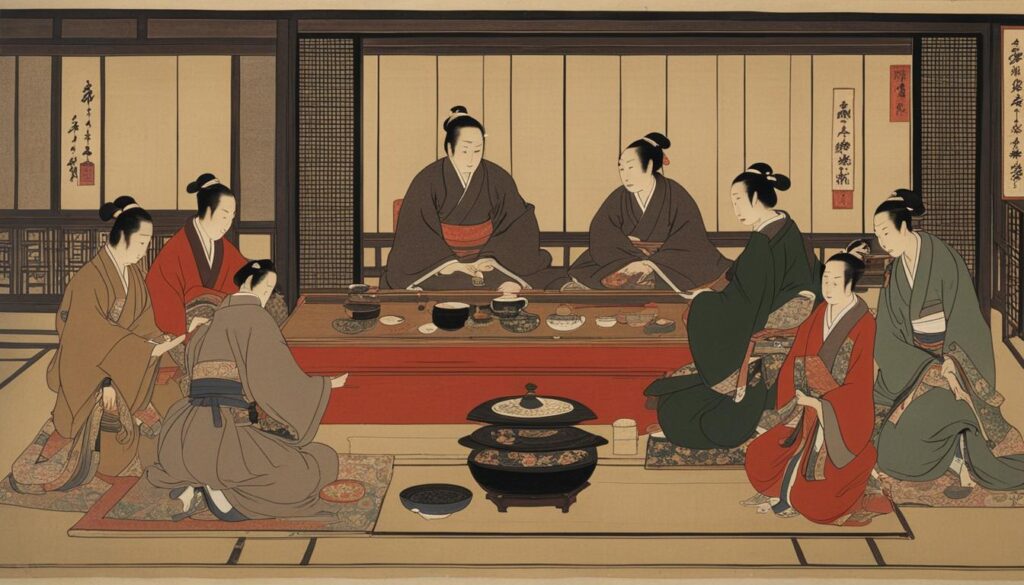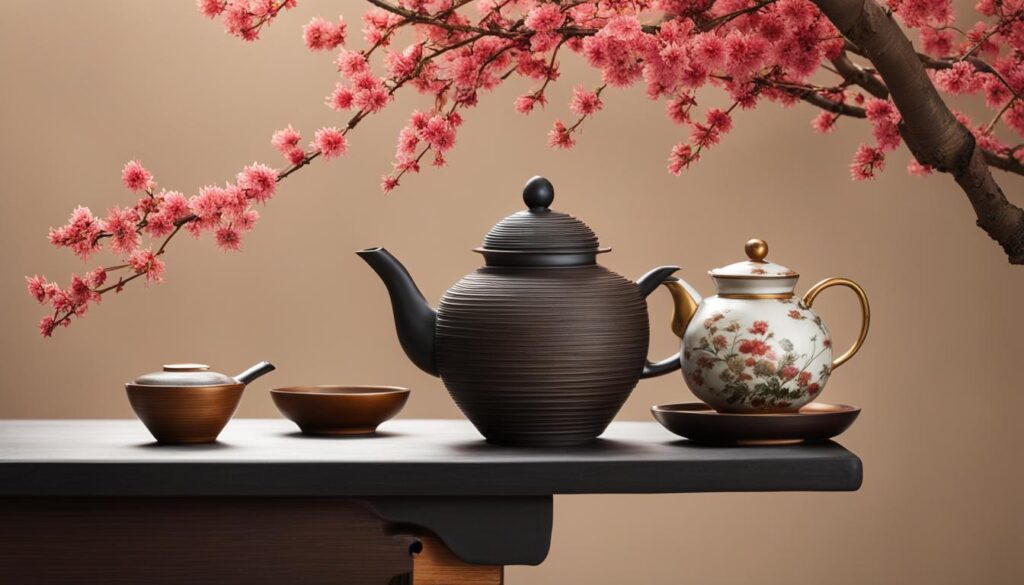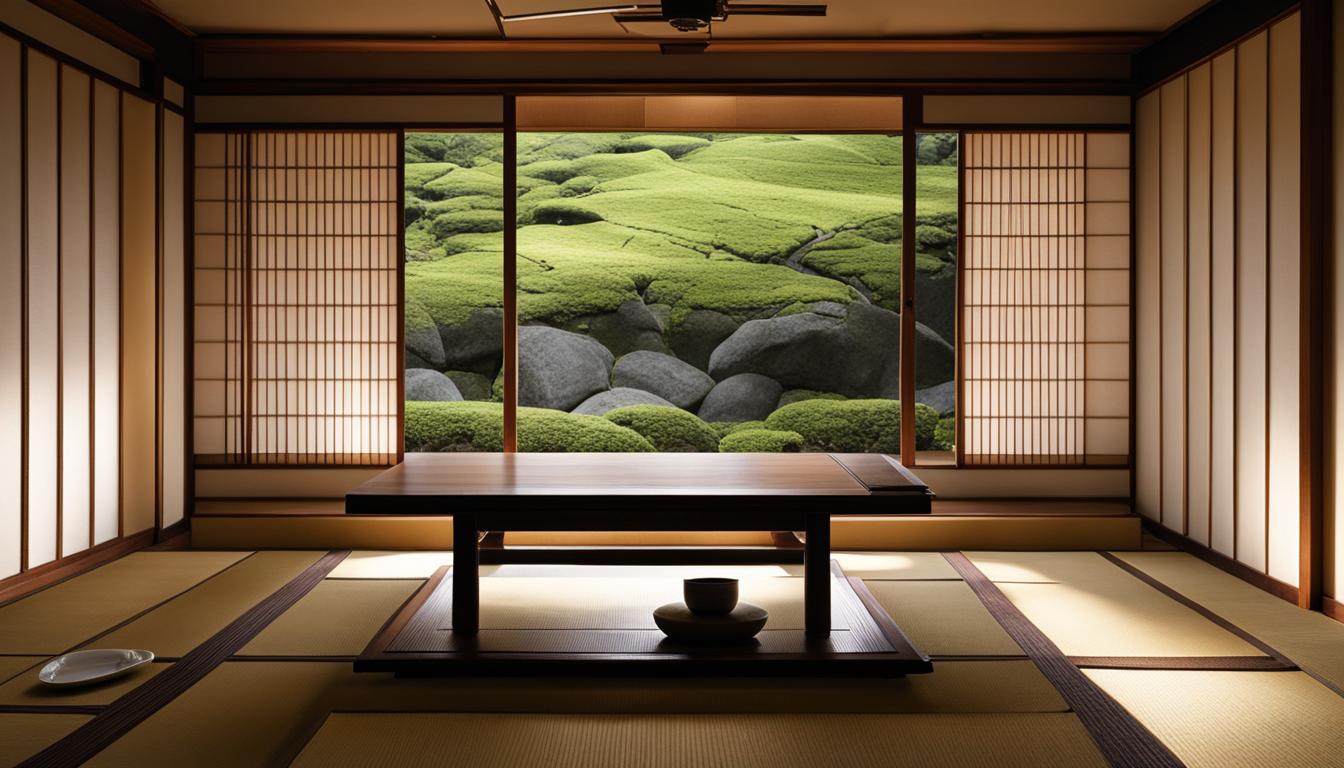Welcome to our exploration of the fascinating world of traditional tea ceremonies! In this article, we will delve into the aesthetics of these ancient rituals from an artistic perspective. Join us as we unravel the beauty, artistry, and principles that make tea ceremonies a truly captivating experience.
Tea ceremonies hold a special place in Japanese culture, where aesthetics are deeply valued. While Western aesthetics often focus on beauty in art, Japanese aesthetics emphasize harmony, simplicity, and the integration of art into everyday life. Traditional Japanese tea ceremonies, known as chanoyu or sadō, embody these principles with their visual allure, meticulous design elements, and artistic expression.
Key Takeaways:
- Tea ceremonies in Japanese culture are deeply rooted in aesthetics.
- The emphasis is on harmony, simplicity, and integration of art into everyday life.
- Tea ceremonies visually captivate through design elements and artistic expression.
- Japanese aesthetics celebrate imperfection, impermanence, and simplicity.
- Tea ceremonies have a rich history influenced by Zen Buddhism.
Japanese Aesthetics and the Tea Ceremony
The Japanese tea ceremony is a captivating display of Japanese aesthetics, showcasing the country’s unique worldview and artistic expressions. Rooted in nature and focused on harmony, the tea ceremony embodies the principles of Japanese aesthetics, creating a serene and visually pleasing experience.
One of the central concepts in Japanese aesthetics is wabi-sabi, which celebrates the beauty of imperfection, impermanence, and simplicity. This philosophy is reflected in the tea ceremony’s emphasis on creating a harmonious atmosphere through minimalistic and rustic elements. The tea bowls, tea utensils, and tea rooms are carefully chosen to embody the essence of wabi-sabi, with their organic forms, earthy colors, and subtle imperfections.
The tea ceremony is not just a visual experience but a multisensory journey that engages all the senses. The aroma of the tea, the sound of water boiling, the texture of the tea bowl, and the taste of the tea all contribute to the overall aesthetic experience. Every aspect of the tea ceremony, from the precise movements of the host to the interaction between host and guests, is designed to create a sense of harmony and tranquility.
In summary, the tea ceremony is a testament to the depth and beauty of Japanese aesthetics. It combines elements of nature, simplicity, and mindfulness to create a visually striking and spiritually enriching experience. The tea ceremony is not just a beverage but a profound artistic expression that continues to captivate and inspire people around the world.
The History and Evolution of the Tea Ceremony
The tea ceremony has a fascinating history that stretches back to ancient times. It originated in China and was introduced to Japan in the 6th century, along with the teachings of Buddhism. Over the centuries, the tea ceremony underwent significant development and refinement, shaped by various cultural influences and philosophical beliefs.
One of the most significant influences on the evolution of the tea ceremony was Zen Buddhism. Zen philosophy emphasizes simplicity, mindfulness, and the pursuit of transcendental truth. These principles resonated deeply with the tea ceremony, leading to its transformation into a spiritual practice centered on harmony, respect, purity, and tranquility.
Two influential figures in the history of the tea ceremony were Sen no Rikyū and Juro Murata. Sen no Rikyū, known as the “father of the tea ceremony,” was a master tea practitioner who played a pivotal role in establishing the tea ceremony as we know it today. He emphasized the principles of wabi-sabi, which celebrates the beauty of imperfection, impermanence, and simplicity. Juro Murata, another tea master, further refined the tea ceremony and introduced new variations, contributing to its ongoing evolution.

The Influence of Zen Buddhism
Zen Buddhism had a profound impact on the tea ceremony, shaping its philosophy, aesthetics, and rituals. Zen emphasizes the practice of mindfulness and being fully present in the moment. This approach is reflected in the tea ceremony, where every movement and gesture are performed with intention and focused attention.
The Evolution of the Tea Ceremony
Over time, the tea ceremony evolved from a simple act of hospitality to a refined art form. It became a means of spiritual expression, self-reflection, and connection with nature. The tea ceremony also became a symbol of status and social standing, as participation in the ceremony was restricted to the aristocracy and elite classes.
“The tea ceremony is a window into Japanese history and culture, reflecting the values and aesthetics of the time. It is a living tradition that continues to evolve and adapt, embracing new influences while maintaining its deep-rooted essence.” – Tea Master Hiroshi Takahashi
The tea ceremony continues to be revered and practiced today, both in Japan and around the world. Its rich history and ongoing evolution make it a fascinating subject of study for those interested in Japanese culture, aesthetics, and traditions.
The Symbolism and Rituals of the Tea Ceremony
In the enchanting world of traditional tea ceremonies, symbolism and rituals play a vital role. Each gesture and step in the ceremony is steeped in meaning, creating a harmonious and serene atmosphere. Let’s explore some of the key symbols and rituals that make the tea ceremony a truly remarkable experience.
Symbols in Tea Ceremonies
The tea ceremony is rich in symbolism, with every aspect carefully chosen to create a deeper connection with nature and the surrounding environment. The tea itself represents purity and tranquility, while the tea room represents a sacred space for spiritual reflection and harmony. The design elements, such as the tea bowls and utensils, often feature natural motifs like flowers, leaves, or landscapes, further emphasizing the connection to the natural world.
Additionally, the act of preparing and serving the tea has symbolic meaning. The precise movements of the tea master reflect grace and mindfulness, while the act of receiving and drinking the tea symbolizes gratitude and respect. The tea ceremony encourages participants to be fully present in the moment, fostering a sense of mindfulness and appreciation for each experience.
Rituals of the Tea Ceremony
The rituals of the tea ceremony follow a carefully choreographed sequence, each step contributing to the overall ambiance and flow of the ceremony. The host meticulously prepares the tea, paying close attention to the temperature, whisking technique, and the amount of tea leaves used. The tea is then served to the guests in a specific order, reflecting the hierarchical nature of the ceremony.
The interaction between the host and the guests is marked by grace and decorum. Guests show their appreciation by bowing and complimenting the host’s tea-making skills. The host, in turn, pays respect to each guest by serving them individually and engaging in polite conversation. The rituals of the tea ceremony create a sense of unity and shared experience, promoting harmony and connection among participants.
| Symbol | Meaning |
|---|---|
| Tea | Purity and tranquility |
| Tea room | Sacred space for reflection and harmony |
| Floral motifs | Connection to nature |
| Precise movements | Grace and mindfulness |
| Order of serving | Hierarchical nature of the ceremony |
The tea ceremony is a dance of symbolism and ritual, offering participants a glimpse into a world filled with meaning and tranquility. Each symbol and ritual contributes to the overall experience, creating a harmonious and serene atmosphere that transcends the ordinary. The tea ceremony is truly a work of art, where every gesture and movement tells a story and invites us to savor the beauty of the present moment.
The symbolic elements and intricate rituals of the tea ceremony elevate it from a simple beverage preparation to a profound artistic expression. It is a practice that encourages mindfulness, appreciation for nature, and connection with others. The tea ceremony is a testament to the enduring beauty of tradition and the power of symbolism to evoke deep emotions and create meaningful experiences.

Tea Ceremony as an Art Form
When it comes to the tea ceremony, it is more than just a simple beverage. It is considered an art form that encompasses various disciplines and requires a deep understanding of aesthetics, philosophy, and meticulous preparations.
The tea masters who practice the tea ceremony are highly respected as artists. Their mastery of aesthetics, combined with their knowledge of tea ceremony traditions, allows them to create an experience that is not only visually captivating but also deeply meaningful.
From the moment you enter the tea room, you are greeted with a serene and harmonious environment that has been carefully designed to enhance the overall artistic expression of the ceremony. The tea bowls, tea utensils, and tea rooms are all chosen with great care, ensuring that every element contributes to the aesthetic beauty of the ceremony.
The Artistry of Tea Ceremony Utensils
One of the key aspects of the tea ceremony as an art form is the attention to detail in the design and creation of the utensils used. Each tea bowl, tea ladle, and tea caddy is not only functional but also a work of art in its own right.
The tea bowls, known as chawan, are carefully crafted by skilled artisans who take into consideration factors such as shape, texture, and glaze. These bowls are often designed to reflect the season or occasion, with unique patterns and colors that add to their aesthetic appeal.
In addition to the tea bowls, the tea utensils used in the ceremony, such as the tea ladles and tea caddies, are also meticulously chosen. These utensils are often made from materials like bamboo, pottery, or lacquer, further enhancing the visual beauty and overall artistic expression of the tea ceremony.
As you can see, the tea ceremony is not just a simple act of drinking tea. It is a deeply artistic and meaningful practice that reflects the beauty and cultural significance of tea ceremony aesthetics. From the design of the tea room to the careful selection of utensils, every element of the tea ceremony is thoughtfully considered to create an experience that is both visually engaging and spiritually fulfilling.
Conclusion
In conclusion, the tea ceremony is a captivating and beautiful tradition that showcases the visual culture of Japan. Its aesthetics are deeply ingrained in Japanese culture and reflect a unique worldview centered on harmony, simplicity, and the integration of art into everyday life.
The beauty of traditional tea ceremonies lies in their meticulous design and decor. From the carefully selected tea bowls and utensils to the serene tea rooms, every element is chosen to enhance the overall aesthetic experience. The attention to detail and the mastery of aesthetics displayed by tea masters further elevate the ceremony to an art form.
The tea ceremony’s visual culture is a synthesis of various artistic disciplines, including architecture, interior design, flower arranging, painting, food preparation, and performance. The ceremony itself is a highly ritualized practice filled with symbolic gestures that create a sense of harmony and tranquility.
Overall, the tea ceremony continues to captivate and inspire people around the world. Its enduring beauty and artistic expression reflect the profound cultural significance of this timeless tradition. By immersing ourselves in the visual culture of tea ceremonies, we can gain a deeper appreciation for the harmonious blend of aesthetics, philosophy, and meticulous preparations that make the tea ceremony a truly unique and captivating art form.
FAQ
What is the significance of aesthetics in traditional tea ceremonies?
Aesthetics play a significant role in tea ceremonies, as they embody the Japanese worldview of harmony, simplicity, and the integration of art with everyday life.
How do Japanese aesthetics differ from Western aesthetics?
While Western aesthetics focus on beauty and value in art, Japanese aesthetics emphasize harmony, simplicity, and the celebration of imperfection and impermanence.
What is the history behind the tea ceremony?
The tea ceremony originated in China and was brought to Japan in the 6th century. It underwent refinement under the influence of Zen Buddhism and the tea masters Sen no Rikyū and Juro Murata.
What are the rituals and symbolism involved in the tea ceremony?
The tea ceremony is a highly ritualized practice filled with symbolism. Each step and gesture has a specific meaning and is intended to create harmony and tranquility.
Is the tea ceremony considered an art form?
Yes, the tea ceremony is seen as a synthesis of various artistic disciplines, including architecture, interior design, flower arranging, painting, food preparation, and performance.
What is the enduring beauty and cultural significance of the tea ceremony?
The tea ceremony reflects the visual culture and profound beauty of Japanese tradition. It continues to captivate and inspire people around the world with its artistic charm.





